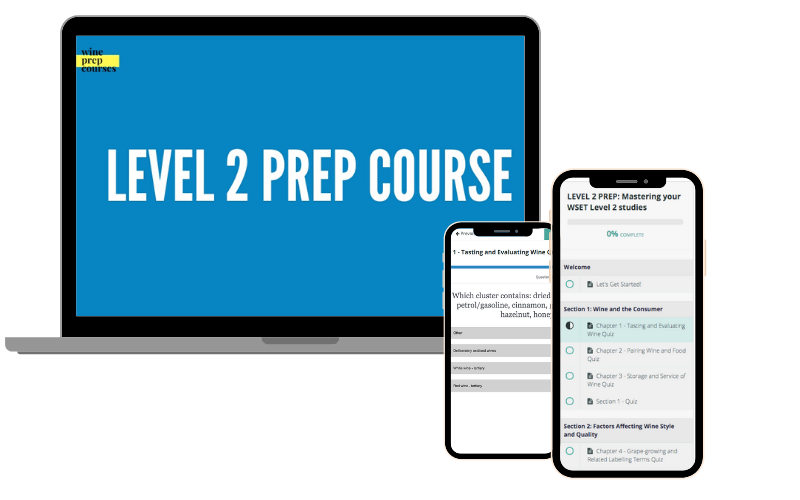Level 2 Course Guide
Considering the WSET Level 2 course? I put together this guide to answer as many questions as possible for you.
L2 was one of my favourite wine courses to study: it has just the right depth of detail plus many interesting and delicious wines to taste! Read on for details on everything from cost to pass rates…
Starting at Level 2
The Level 2 course is designed for beginner to intermediate level students who want to explore the world of wines. If you’re looking for a solid understanding of wine, this qualification will teach you the major grape varieties and key wine regions of the world. You’ll learn about the different styles of wines produced, as well as important wine classifications and labeling terms. All this, while tasting through a spectrum of wines as you go!
Many students begin their WSET journey in L2, rather than in Level 1, as L2 is a good jumping off point even for those with little or no wine knowledge. Level 1 is quite brief and basic, with few wines tasted. If you have some familiarity with wine grapes and regions, but would still like more confidence, this is the place to begin. Level 3 represents a huge leap in breadth and detail from L2.
For free Level 2 quizzes and other study resources, visit our WSET Study tools page.
What does the WSET Level 2 curriculum cover & what will you BE learnING?
How to taste and describe wine using WSET’s tasting regimen, which they call the “Systematic Approach to Tasting Wine” (the SAT). This system gives you a foundation for assessing a wine’s flavours and aromas, plus structure (such as body, acidity, and tannins). When you master this approach, you’ll have the confidence to taste different wines and judge them on typicity (aka do they taste like the stated grape/s), and quality.
How environmental factors like climate, grape growing methods, winemaking techniques, and maturation options such as oak barrels, all work together to create the style and quality of wines made from the eight major or ‘noble’ varieties: white wine grapes Chardonnay, Pinot Grigio/Pinot Gris, Sauvignon Blanc, and Riesling, plus red wine grapes Cabernet Sauvignon, Merlot, Pinot Noir, and Syrah/Shiraz.
You’ll also cover some lesser known but important grapes that are found in over 70 regions (yes, you’ll be able to recognize these grape names and many of the regions on the wine list when you’re done!): white wine grapes Albariño, Chenin Blanc, Cortese, Fiano, Furmint, Garganega, Gewurztraminer, Sémillon/Semillon, Verdicchio, and Viognier, plus red wine grapes Barbera, Carmenère, Corvina, Gamay, Grenache/Garnacha, Malbec, Montepulciano, Nebbiolo, Pinotage, Sangiovese, Tempranillo, and Zinfandel/Primitivo.
You’ll be finding out how grape varieties and different winemaking processes influence the key styles of sparkling wines, such as Asti, Cava, Champagne, Prosecco and new world bubblies (Australia, California, New Zealand, South Africa), plus the flavourful spectrum of fortified wines Sherry, and Port.
How to read wine labels - you’ll study the common labelling terms, and learn to interpret and compare a variety of labels.
Principles and processes involved in the storage and service of wine, such as the best ways to store your wine, and what temperatures different wine styles should be served at.
Principles of food and wine pairing, including how flavours such as salt, sweet, umami and spice in food can change the way your wine tastes, and vice versa.
How long does it take to study for WSET Level 2?
The Wine & Spirit Education Trust, which administers this program, suggests a minimum of 28 hours of study time, which will vary by the school you choose to work with:
16+ hours with your WSET course provider (either in classroom or online)
11+ hours of personal study / revision time
A one hour examination, in person - OR - new, WSET have added the option to take your exam online for Level 2
What’s the WSET Level 2 exam like?
The exam is comprised of a one hour closed book test where you’ll need to answer 50 multiple choice questions. No wines are tasted during the exam, and there are no written answers required, just the multiple choice!
If you’re successful and pass the exam, you’ll receive a certificate and snazzy lapel pin, and can use the associated WSET certified logo.
The test is very fair, and based entirely off the material in the class textbook, which was recently revised, called Wines: Looking behind the label (76 pages long, lots of pictures). Some students have commented that the exam questions can be a bit more tricky than expected based on the samples in their workbook, but the topics are always from within the book, and some are verbatim from the text.
How much does WSET Level 2 cost?
Good question! The price can range, with in person classes costing more than online. This is because in person, you’ll be tasting quite a few wines. I recommend doing the class in person if possible, and looking for the most sessions offered rather than condensed classes. That way you have time to do your readings each week, and really enjoy tasting the different wines without feeling rushed (the timelines can range from a one weekend course to 8 weeks long). There is a lot of time and work involved in sourcing the right wines to taste, and trying to organize this independently is one of the most often mentioned challenges I’ve heard from online students, along with the feedback that they struggled to learn the tasting strategy.
Tuition generally includes the school’s registration fees, a student study kit (textbook, laminated tasting sheet, and a study workbook), exam fee, and course tuition. Some schools provide glassware, but most will offer you a set of 6 ISO tasting glasses for purchase.
The prices below for in-person courses are exclusive of taxes and current as of 2022, so you can compare apples to apples:
IWC, New York: $862.43USD
Capital Wine School, Washington DC: $695USD
Florida Wine Academy: $895USD
Napa Valley Wine Academy, Napa: $889USD
Fine Vintage, Vancouver: $995CAD
Neptune Wine, SoCal: $830USD
San Francisco Wine School: $895USD
The Wine & Spirit Archive, Seattle: $755USD
Texas Wine School: $679USD
East London Wine School: 385GBP
How to choose a WSET school?
Getting your money’s worth takes just a little extra research. Here’s what I recommend you look for when choosing a provider (or APP, “Approved Program Provider”):
How many sessions are included, and how many hours of class time each session? More is better!
How many wines are tasted in total, and do they have a list they can show you? Ideally they are buying top quality samples that will give you a broad foundation in tasting. Take a look at the school’s instagram, or IG tags to check out the wines being tasted.
Who is teaching your course? Ideally you can talk to someone who’s learned with the instructor before. Having an entertaining teacher in Level 2 is very important to your enjoyment of the course, in fact, I’d say passion communicating about wine is key, even more so than impressive wine credentials!
See the note below about passing rates, as some schools have better passing rates than others.
Entry Requirements: Do I need to have completed WSET Level 1 to enter Level 2?
There are no entry requirements for the L2 qualification, you can start here without doing Level 1. You’ll need to be of legal drinking age in the country where you attend the course, as you’ll be tasting wines.
How hard is it to pass Level 2?
Students who earn a score of 55% receive a WSET Level 2 award. Students who score 70% - 84% pass with Merit on their certificate. Those who earn a score of 85% or more pass with Distinction. Here’s the official register:
Mark of 85% and more = Pass with Distinction
Mark of between 70% - 84% = Pass with Merit
Mark of between 55% - 69% = Pass
Mark of between 45% - 54% = Fail
Mark of 44% and under = Fail unclassified
Globally, WSET’s average pass rate for this level is 90% (ie 90% of students achieve a pass on the exam).
Look for a pass rate to be quoted by your school/APP, as it can be a sign that their teaching is better than average.
For example, San Francisco Wine School says their WSET Level 2 pass rate is 95%, and Fine Vintage quotes a pass rate of 94%.
Can you Challenge your grade OR GET AN EXPLANATION FOR A FAIL?
Yes, you can challenge a grade or ask for more detail on your result. To do this, use an Enquiry and Feedback form provided by your school. There is a fee charged by WSET for this service. The completed form must be received by WSET within 6 weeks of your exam date.
CAN you reschedule or resit the Level 2 exam?
Most schools will want at least 15 business days in order to register you for an upcoming exam date, this can vary by school.
Expect to pay approximately $120USD to resit a previously failed exam, or about $175USD to reschedule an exam that you needed to withdraw from. Some schools will organize a private exam if it is needed, for a fee of course! The fees for the options listed here will vary by provider, and are mentioned as a guideline only.
You have 12 months from starting the course to write your exam.

